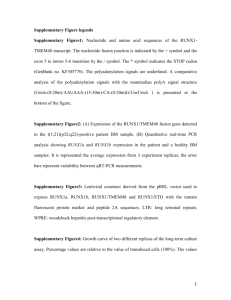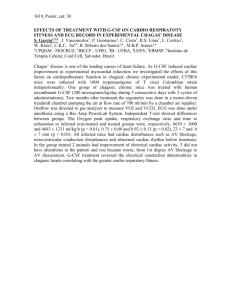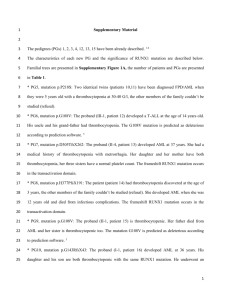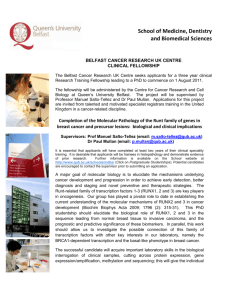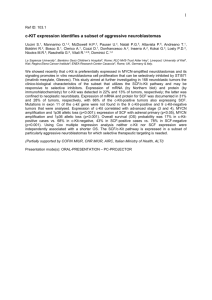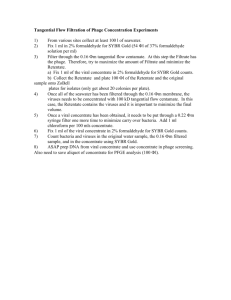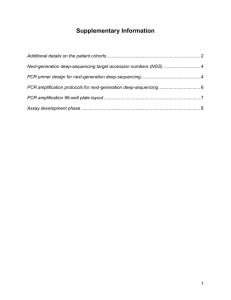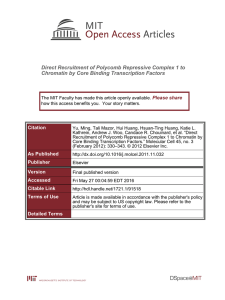Supplementary Information (docx 134K)
advertisement
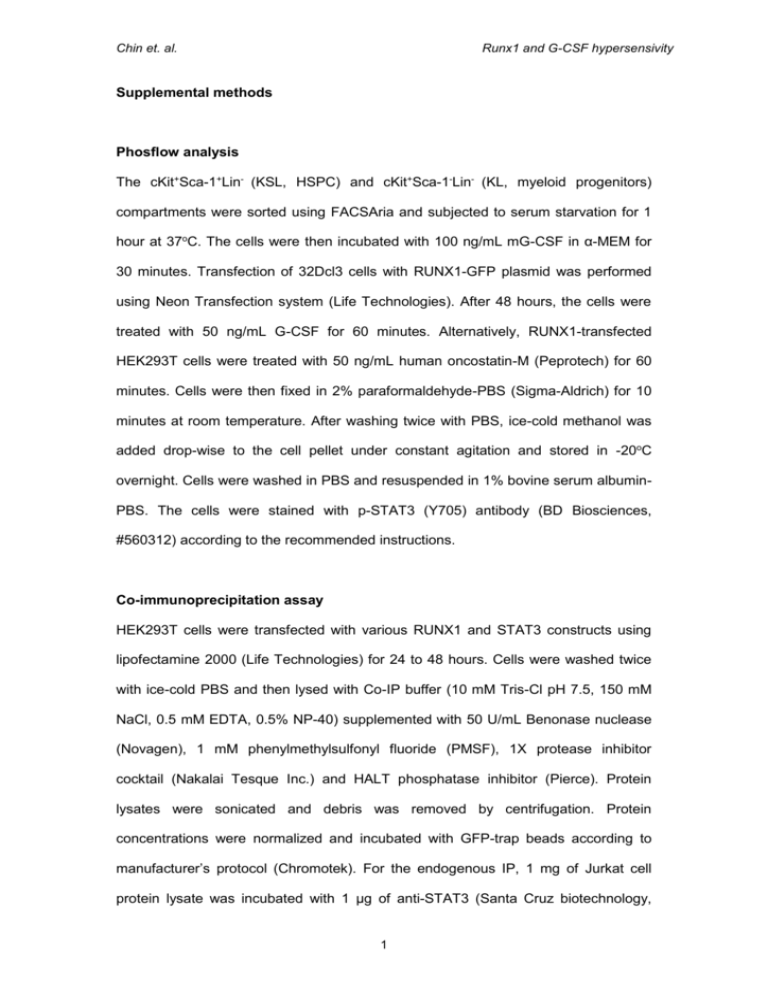
Chin et. al. Runx1 and G-CSF hypersensivity Supplemental methods Phosflow analysis The cKit+Sca-1+Lin- (KSL, HSPC) and cKit+Sca-1-Lin- (KL, myeloid progenitors) compartments were sorted using FACSAria and subjected to serum starvation for 1 hour at 37oC. The cells were then incubated with 100 ng/mL mG-CSF in α-MEM for 30 minutes. Transfection of 32Dcl3 cells with RUNX1-GFP plasmid was performed using Neon Transfection system (Life Technologies). After 48 hours, the cells were treated with 50 ng/mL G-CSF for 60 minutes. Alternatively, RUNX1-transfected HEK293T cells were treated with 50 ng/mL human oncostatin-M (Peprotech) for 60 minutes. Cells were then fixed in 2% paraformaldehyde-PBS (Sigma-Aldrich) for 10 minutes at room temperature. After washing twice with PBS, ice-cold methanol was added drop-wise to the cell pellet under constant agitation and stored in -20oC overnight. Cells were washed in PBS and resuspended in 1% bovine serum albuminPBS. The cells were stained with p-STAT3 (Y705) antibody (BD Biosciences, #560312) according to the recommended instructions. Co-immunoprecipitation assay HEK293T cells were transfected with various RUNX1 and STAT3 constructs using lipofectamine 2000 (Life Technologies) for 24 to 48 hours. Cells were washed twice with ice-cold PBS and then lysed with Co-IP buffer (10 mM Tris-Cl pH 7.5, 150 mM NaCl, 0.5 mM EDTA, 0.5% NP-40) supplemented with 50 U/mL Benonase nuclease (Novagen), 1 mM phenylmethylsulfonyl fluoride (PMSF), 1X protease inhibitor cocktail (Nakalai Tesque Inc.) and HALT phosphatase inhibitor (Pierce). Protein lysates were sonicated and debris was removed by centrifugation. Protein concentrations were normalized and incubated with GFP-trap beads according to manufacturer’s protocol (Chromotek). For the endogenous IP, 1 mg of Jurkat cell protein lysate was incubated with 1 μg of anti-STAT3 (Santa Cruz biotechnology, 1 Chin et. al. Runx1 and G-CSF hypersensivity #Sc-482), anti-RUNX1 (Abcam, #Ab35962) or control IgG antibody. Protein A/G agarose beads (Calbiochem, #IP-10) were added into the lysates and incubated for 3 hours. Beads were washed 5 times with Co-IP buffer. Bound proteins were eluted with 2X SDS sample buffer and then subjected to western blot analysis. Western blot analysis Cells were lysed in 5x packed volume of 4% SDS solution and protein concentration was estimated using BCA protein assay reagent (Pierce). Equal amounts of protein were loaded and resolved using 8% to 12% SDS-PAGE gels. The membrane was blocked using PBS with 2% BSA (Sigma-Aldrich) and 0.1 % Tween-20 (SigmaAldrich). Antibodies against RUNX1 (MBL, #D208-3, 1:1000; Active Motif, #39000, 1:1000), GFP (Abcam, #290-50, 1:4000), HA (Santa Cruz biotechnology, #sc-7392, 1:1000), β-Actin (Sigma, A1978, 1:5000), STAT3 (Cell Signaling Technology, #12640S, 1:1000; Santa Cruz biotechnology, #Sc-482, 1:1000) and phospho-STAT3 (Tyr705) (Cell Signaling Technology, #4113S, 1:1000) were used. 2 Chin et. al. Runx1 and G-CSF hypersensivity Supplemental table 1 List of antibodies used for flow cytometry. Antigen Antibody Clone CD3 CD4 CD8 B220 Gr-1 Mac-1 Ter-119 CD127 CD71 CD41 CD61 CD16/32 c-Kit Sca-1 Flt-3 CD45 CD34 STAT3 (pY705) 145-2C11 H129.19 53.6.7 RA3-6B2 RB6.8C5 M1/70 TER-119 A7R34 C2 MWReg30 2C9.G2 2.4G2 2B8 D7 A2F10 30-F11 RAM34 4/P-STAT3 3 Chin et. al. Runx1 and G-CSF hypersensivity Supplemental table 2 List of primers and probes used for real-time quantitative PCR. Gene Dye Pias1 SYBR Pias2 SYBR Pias3 SYBR Pias4 SYBR Socs1 SYBR Socs2 SYBR Socs3 SYBR Socs4 SYBR Socs5 SYBR Socs6 SYBR Socs7 SYBR Hprt1 SYBR Csf3r SYBR PIAS3 SYBR HPRT1 SYBR Cxcr4 Ptprc Gapdh Taqman Taqman Taqman Sequence (5' -3') Forward Reverse Forward Reverse Forward Reverse Forward Reverse Forward Reverse Forward Reverse Forward Reverse Forward Reverse Forward Reverse Forward Reverse Forward Reverse Forward Reverse Forward Reverse Forward Reverse Forward Reverse ID ID ID AGTGCGGAACTAAAGCAAATGG TTTTCTGAGGGAACCGCCTC TGCCCAGTGTGACTTCAGTT GAGGTGAGACTGGGGATCAA CCAGGCCAGAGCTTCATGGATAC TGCCTTTCCCCAAGAGGCT GAGAAGCTTCGCCTAGACCC CGACAGCAGCCCATCTATGA GGCTCACTGCCTCTGTCTC AAGGTGCGGAAGTGAGTGTC CCCGTGTGAAATCCAAGGCT AGGAGTGCAAGGGCAATGTC TTGAGCGTCAAGACCCAGTC CGTGGGTGGCAAAGAAAAGG CCACACCCAGATCGACTACG TGGCTTTCCTTCCAGCAGAG TGAACCCCAACAGATGTCCG CACAGTTTTGGTTCCGCCTG CCTTCAGTACACCGTGCCTT GGCTCTGCAACATGACTCCT TATCAGTGGGACGCTGCCTA CTGCAAAGCTGCTTGAGTCG CAGTCCCAGCGTCGTGATTAG AAACACTTTTTCCAAATCCTCGG CCTGGATGATAGAACCTAACGGG CTCTCCAGCGAAGGTGTAGACA GATTGGGAAGGGCACAGG ACTTCCCCTGCCTCCTACTCC ATTCTTTGCTGAGCTGGATT CCAATTACTTTTATGTCCCCTGTTG Mn99999051_m1 Mn01293577_m1 Mn99999915_m1 4 Chin et. al. Runx1 and G-CSF hypersensivity Supplemental figure legends Supplemental figure 1. Runx1+/- mice show mild defects in platelet production. (A) Complete blood count (CBC) performed on 6 to 8 week old Runx1+/+ (n= 11) and Runx1+/- (n= 14) mice. Mean ± SD of leukocyte count, hemoglobin and platelet quantities are shown. (B, C) Frequencies of cells in the bone marrow (BM) (B) and spleen (C) of 6 to 8 week old Runx1+/+ and Runx1+/- mice. B cells, B220+CD19+; Myeloid, Mac-1+ and Gr-1+; Megakaryocyte (MgK), CD41+CD61+; T cells, CD3+. Mean ± SD are shown (n= 7/genotype). (D, E) Representative flow cytometry plots (left) and graphical representation (right) of the frequencies HSPC compartments gated from viable Lineage- cells of Runx1+/+ and Runx1+/- mice in the BM (D) and spleen (E) at 6 to 8 week old. All data represent mean ± SD (n= 7/genotype). Asterisks represent significant differences (* p < 0.05, ** p < 0.01, *** p < 0.001, 2tailed Student’s t test). Supplemental figure 2. Runx1+/- mice exhibit acute granulocyte colonystimulating factor hypersensitivity in vivo, related to Figure 2. (A- C) Representative flow cytometric plots of the HSPC compartments in the bone marrow (BM) 24 hours after 250 μg/kg/day granulocyte colony-stimulating factor (G-CSF) stimulation in vivo for 3 consecutive days. Plots of 0.2 – 1 x 106 cells were gated from Lineage- cells (A), c-Kit+Sca-1+Lineage- (KSL) cells (B) and, c-Kit+Sca-1-Lineage- (KL) cells (C). (D, E) Graphical representation of the frequencies of various HSPC compartments in the BM, 24 hours after 250 μg/kg/day G-CSF stimulation in vivo for 3 consecutive days. All data represent mean ± SD (Runx1+/+ mice PBS control, n= 4; Runx1+/- mice PBS control, n= 4; Runx1+/+ mice G-CSF-treated, n= 6; 5 Chin et. al. Runx1 and G-CSF hypersensivity Runx1+/+ mice G-CSF-treated, n= 6). Abbreviations: HSPC, hematopoietic stem and progenitor cell (c-Kit+Sca- 1+Lineage-); LT-HSC, long-term hematopoietic stem cell (c-Kit+Sca- 1+Lineage-CD34-Flt3-); ST-HSC, shortterm hematopoietic stem cells (c-Kit+Sca-1+Lineage-CD34+Flt3-); MPP, multipotent progenitor (c-Kit+Sca-1+Lineage-CD34+Flt3+); CMP, common myeloid progenitor (c-Kit+Sca-1-Lineage-CD34+FcγRlo); GMP, granulocyte macrophage progenitor (c-Kit+Sca-1-Lineage-CD34+FcγRhi); MEP, megakaryocyte erythroid progenitor (c-Kit+Sca-1-Lineage-CD34-FcγRlo). Asterisks represent significant differences (*, p < 0.05, Student’s t test). Supplemental figure 3. Runx1+/- mice sustain hematopoietic stem and progenitor mobilization at 72 hours post granulocyte colony-stimulating factor stimulation, related to Figure 2. (A- C) Graphical representation of the frequencies of HSPC compartments in the bone marrow (BM) gated from Lineage- cells (A), LT-HSC, ST-HSC and MPP compartments gated from KSL cells (B), and CMP, GMP and MEP compartments gated from KL cells (C) 72 hours after in vivo granulocyte colony-stimulating factor (G-CSF) stimulation (250 μg/kg/day for 3 days). (D, E) Graphical representation of the frequencies of HSPC compartments (D) and GMP (E) in the spleen 72 hours after in vivo G-CSF stimulation (250 μg/kg/day for 3 days). All data represent mean ± SD (Runx1+/+ mice G-CSFtreated, n= 4; Runx1+/- mice G-CSF-treated, n= 4). Abbreviations see supplemental figure 2 legends. Asterisks represent significant differences (* p < 0.05, 2-tailed Student’s t test). 6
